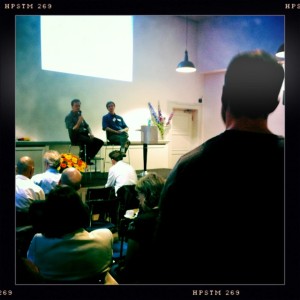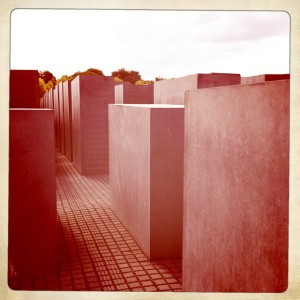I’m sitting on my bed beside an open window in my Frankfurt hotel room, listening to the raucous cheers of crowds in the streets as Germany wins a key quarter-final World Cup soccer match (against the poor Greeks, of all people). These joyous Germans have flags flying from their cars; many have painted their faces in the national colors of red, gold and black; the sounds of horns and fireworks are everywhere. It’s good fun, not unlike the street celebrations in my home city of Denver when our beloved Broncos won the Superbowl.
But apparently it’s very unusual for the Germans. As one of my hosts told me: “a few years ago if you had flown a German flag people would have wondered if you were a Nazi.” Another told me that his elderly mother was so frightened by the TV images that she left the room when the sportscasts came on.
Germans have a well-developed immune system when it comes to expressions of nationalism. After the first half of the 20th Century, one can see why. My colleague Brett Walker and I spent an afternoon last week visiting the Holocaust Museum in Berlin. The stories and images of that catastrophe are well-known, as is as the body count of well over six million souls.
What is all the more horrifying is the means with which it was conducted. Genocide itself is not remarkable in human history. At tribal (magenta) and warrior (red) stages of development, a society secured its future by ridding the land of its enemies, and they did it with the same compassion we feel for the germs we “kill by millions” when we gargle with Listerine. Good riddance! Good hygiene!
But what’s stupefying about the Holocaust is that this pre-modern activity of genocide was conducted with modern technology; not with clubs and swords (the technology of pre-modern societies), but with railroads, gas chambers and crematoria that operated with the efficiencies of modern logistics management.
Contemporary Germans are as a horrified by all this as as anyone, more so in fact. And as a result they have extra antibodies to any idea or message that smacks of arrogance. This shows up in the German integral movement as well, a lesson I’m afraid I learned a bit the hard way as I traveled through the country speaking to integral groups. Not everyone here has been charmed by my message of integral optimism.
The opening speaker at the Integrales Forum Conference, raised in Switzerland with deep understanding of German culture, warned against “integral evangelism”, and any claims of being “thrilling or elevated” by the teachings of integral theory. Most of the German audience found this message edifying; I found it demoralizing.
To be sure, my thesis of social progress is a tough sell for progressive groups anywhere (hey, I just realized the irony of that statement — I wish they would!). After all, “progress” is the justification that orange modernity has used for hundreds of years to oppress and plunder less-developed cultures. So one of they key tasks of green post-modern consciousness is to deconstruct all ideologies of progress and their resulting hierarchies of domination, and to aggressively challenge any idea that one culture, person or idea is “better” than any other. Integral consciousness of course includes this great green insight. But how does it transcend it?
One way is by noticing that like every stage of development, Green overcorrects for excesses of the previous stages, thus creating its own excesses. And so it deconstructs not just the dominator hierarchies of modernity and pre-modernity, but also all “natural hierarchies” as well. Dominator hierarchies consist of some version of “when everyone is finally converted to my way of thinking, then everything is going to be okay.” For amber traditionalists it’s “When everyone converts to my religion or ideology then everything will be okay”; for orange modernists it’s “When everyone loses their superstitions and becomes rational then everything is going to be okay.” Green has its own version, exemplified by John Lennon in his song, Imagine: “Imagine there’s no heaven … countries … religion … and the world will be as one.”
At integral consciousness we see that all these systems have a piece of the truth, and indeed themselves arise in a natural order, a natural hierarchy, as the kosmos evolves. We hold no hope that everyone will be converted to anything, including integral consciousness, or that there is any end stage. It’s a natural hierarchy all the way up and all the way down — and that’s okay! But not when natural hierarchies get conflated with dominator hierarchies.
For instance I had a friendly back-and-forth with a participant at the Berlin conference who challenged my assertion that “acorns grow into seedlings, which grow into saplings, which grow into oaks, and never the other way around.” He countered that oaks then produce acorns, which is a circular process. Perfectly true, I agreed, and insisted that still, oaks never grow backward, an oak into an acorn. The growth of the individual tree is a linear process that goes in one direction, and not in the other. No exceptions? Nope, never. We parried a bit, neither conceding, till finally he got to his real sticking point: “My problem is not necessarily with what you say, but with the certainty with which you say it. We Germans have not so long ago suffered deeply from this kind of certainty.”
It was a touching moment for me, because it gave me insight into the heavy karma that Germans carry, having such an egregious and relatively recent example of a dominator hierarchy gone barking mad. Again, no culture or people has been free from the carnage of history, certainly not the US, starting with the often active genocide of Native Americans right up to our recent naive attempts to “bring democracy to the Middle East.” But we’re all learning, and the Germans “are doing their shadow work,” as we say in integral circles, emerging cleansed and grown into one of the most evolved societies on the planet in all four quadrants.
Case in point: they placed the Holocaust Museum — which as public art creates a disturbing experience of being lost in a chaotic cemetery — smack in the epicenter of Berlin, a block from the Brandenburg Gate, on the very site of Hitler’s Imperial Chancellery of the Third Reich. It opened just seven years ago, in 2005. The following year the Germans hosted their first World Cup, and tentatively began waving their flag again. As my Frankfurt host told me, “that was when it began to be okay to be German again.”
After two weeks of traveling around this deeply civilized and egalitarian country it sure is okay with me. Auf wiedersehen meine lieben Freunde!









Well, I don’t want to scare you, but some developmental models (Cook-Greuter’s ego development, eg.) see deconstruction as just normal and not particular to Green. Look, no one is deconstructing without constructing too. Only, we might not be able to articulate the construction part YET, being kind of lost in the “lies” of the past kind of gig. It is indeed a work in progress that could very well go unheard in any top down focused dynamic, especially if it is perceived as “pressure to evolve or transform.”
Well, where’s the relationship in “it’s safe to say she’s green.” “she also appears to be an enneagram Four,” “so everything is a psychodrama for her.” ? Do you ever ask why Green is called “Individualist” on Cook-Greuter’s model? And that this question, “Jeff, have you written her personally?” might pop up repeatedly? Gee, could it make a difference?
But, I took Jordan Luftig’s Enneagram class in my Integral Theory program, and typed on that assessment 26:Ennea 4 and 25:Ennea 5. I do identify more with Ennea type 4, just so you know. Whether or not Maureen Dowd is a type 4 because you might feel annoyed is another matter.
Also, I do see some correspondence between Ennea. type 4 (existential issues – oh… so melodramatic maybe) and Green, mostly because in our IT program I became used to being tagged as Green in our on-line dynamics. And, some into the enneagram say stuff like this, “Type 3 is Orange, Type 4 is Green and Type 7 is Teal (integral).” Yeah, okay here true and partial is a principle we can all entertain at least, even at Green.
And finally WHY I LOVE GREEN! In whatever worldly adventures I can safely fall back here. Whatever “Nazi Germany” exists in your head, it will not happen again under any observance called Green. The Strategist – Teal – Integral focuses on systems and often ignores the individual. Example (besides she’s just type 4 and Green), “Germans have a well developed immune system when it comes to expressions of nationalism;” “Genocide itself is not remarkable in human history;” “What is stupefying about the Holocaust is that this pre-modern activity of genocide was conducted with modern technology; not with clubs and swords……..” I discovered one day in my IT program that my program director did not know the name of anyone in the JFKU office. Call that some Type 4, Green, Individualist anxiety if you want to. What I call it is an over reliance on systems. You are not going to connect to Green if you are just drop kicking shit in baskets called THEM and IN and OUT and HISTORY.
If you’re game, I recommend this book by Martin Matustik called “Postnational Identity.” If you want to play with Enneagram Type 4’s then consider Kierkegaard in relation to integral emergence. (EVEN THOUGH Kierkegaard never took any such assessment.)
The US caused the financial crises, I wonder when this Karma consciousness is reaching the american spiritual scene.
Hey, thank you so much for this article. In Hannover, you gave me an big insight regarding integral practical issues – the I-YOU-IT -religious approach and its interaction which helped me lot with my inner diremption…it it will help a lot for my expedition in Bhutan. All the best for you and your work.
Rabea from Berlin
As a European soccer (or football!) fan I should just point out that it was the European championships, not the World Cup. Other than that a great article.